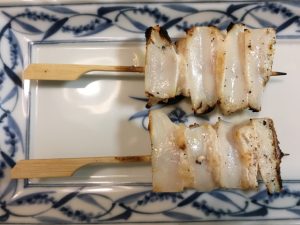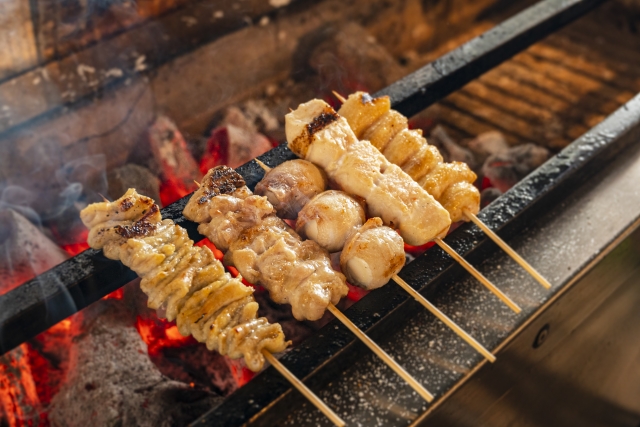Yakitori is also called “Yakitor” in Japanese. It is a dish where various parts of chicken are skewered and grilled. In Japan, besides chicken thigh and breast, various other parts are eaten, such as skin, cartilage, heart, neck (seseri), and tail (bonjiri).
The common seasoning options are “tare,” which is a sweet and savory sauce, and “shio,” which is salt-only seasoning. You can choose between “tare” and “shio” when placing an order. In Japan, “SALT” is referred to as “shio.”
Yakitori is often cooked over charcoal, but there are also shops that use gas fire. Since it is not cooked with oil, excess fat drips off. Since the quantity per skewer is not large, it is common for one person to eat around 5 to 10 skewers comfortably.
It is more commonly eaten as a snack with alcohol rather than as a side dish for rice. The author, too, tends to eat it more as a snack with alcohol.

I think there are few people who have eaten skin or cartilage, don’t you think? The skin is thin because it’s just skin, but excess oil drips off, making the outside crispy and the inside chewy. It goes amazingly well with beer! The author often eats it with tare sauce.

Cartilage has a light taste, and the basic seasoning is “shio” (salt). It often contains chicken breast meat between the bones. You might think, “Do you eat the bones?” but they are soft and crunchy, and they also pair excellently with beer!
Apart from skin and cartilage, there are various other types, so please try ordering them as well.
Yakitori can be eaten at convenience stores, supermarkets, izakayas (Japanese pubs), and yakitori specialty shops. It’s available throughout Japan.
At convenience stores, it’s sold as a hot snack next to the cash register. In supermarkets, it’s often sold in packs of around five skewers.
I recommend izakayas or yakitori specialty shops. Freshly grilled yakitori is fragrant and the most delicious. The meat is also juicy!
When looking for a yakitori specialty shop, if you see smoke billowing outside the shop, it’s often a sign of either a “yakiniku” (grilled meat) or a yakitori place. Izakayas also often have yakitori. In the case of chain stores, the quality of yakitori can vary greatly, so if you don’t find the first one particularly tasty, don’t hesitate to try another shop! Even Japanese people sometimes think, “The yakitori here isn’t that good.” So, it’s an experience everyone goes through!

